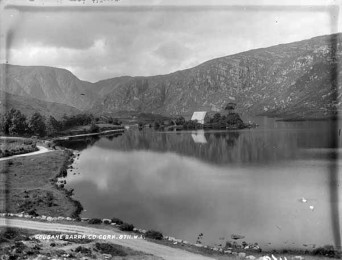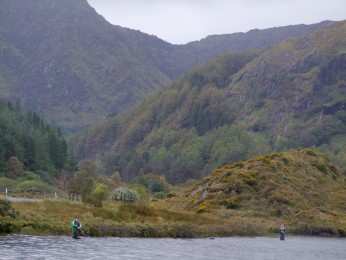
Kieran’s Our City, Our Town Article,
Cork Independent, 10 November 2011
In the Footsteps of St. Finbarre (Part 274)
Memories of Afforestation
There are many well worn spots in Gougane Barra where people stop to photograph the lake, the mountains and the forestry. Indeed, apart from the work of the Irish Tourism Association, another important state supported project in Gougane Barra was that of the Irish Free State Forestry Programme in the late 1930s. Subsequently the forest area became Ireland’s first national park in 1966.
The minutes of Dáil Éireann for the 27 April 1937 record a speech by Gerald Boland Minister of Lands (brother of Harry Boland & a founder member and first chief whip of Fianna Fáil), who noted that “Ireland had been denuded of trees to a greater extent than any other country”. The policy of his Department was to remedy the situation and secure an adequate timber supply for the country at a future date. The programme aimed to be carried out over a number of years and the plan was to plant 10,000 acres yearly.
Prior to 1937, the total area of the new plantations formed by the State was approximately 55,000 acres. The balance of 109,000 acres comprised old woodlands in existence at the time of acquisition, scrub lands not yet cleared for planting, bare land ready for planting, unplantable lands and a number of small areas let in grazing. The total number of Free State forests centres in 1937 was 81, nearly double the number of centres in existence four or five years previously.
About 7,200 acres of forestry were planted in the years 1935-36. However, the Dáil Éireann minutes and an article in the Irish Press on 28 April 1937 highlight that there were a number of factors which had slowed down progress. There was the difficulty of obtaining suitable land in sufficiently large areas and the shortage of skilled forestry officials. Arrangements had been made with the Land Commission for the allotment for forestry purposes of about 6,000 acres and negotiations were pending with private owners for the purchase of 10,500 acres.
Notwithstanding difficulties it was intended to create new centres where possible, and particularly to extend forestry operation in the west and south of the country. The possibility of starting forestry operations in the Gaeltacht received much attention and very considerable areas were inspected. Much of that land obtainable had to be rejected as unsuitable either owing to exposure or to poor soil conditions or to a combination of bother reasons. The search did yield lands suitable for a plantation at Coomroe besides Gougane Barra. It was gradually planted over the ensuing four years. Plantings were largely of Sitka spruce, Lodgepole pine, Japanese larch and some Scots pine. Having reached maturity some of these areas were in time harvested and restocked with a wider variety of species. However, one of the finest stands of Sitka spruce in the country still exists in the valley bottom with trees reaching 38 meters high and carrying a volume of up to 3 cubic meters each.
At the new Free State centres, one of the issues was the length of time to train staff. The majority of the supervisory officers were trained by the State and this was pursued at the Forestry School at Avondale, Co. Wicklow. Provision was also made for further increases to the staff of foresters and foremen, as the work was still hampered by the lack of trained men. The Department had already tried to get suitable men from outside, and the Civil Service Commissioners held open competitions for the purpose. However a sufficient number of qualified candidates were not available. The Department had to, therefore, wait until it had trained its own apprentices.
With the aim to plant 10,000 acres of forestry annually, the State nurseries were enlarged. Hence, in 1937, the amount required for seeds, seedlings and transplants had been reduced from E.125,000 to £6,500 as the State nurseries had been more than doubled in area between 1935 and 1937. The purchases in 1937 were about 325,00 transplants and 515,000 seedlings from Irish Free State nurserymen, 150,000 transplants and 345,000 seedlings from Great Britain, and 995,000 transplants and 475,000 seedlings from the European continent. The number of men employed on national forestry schemes during March 1938 was about 1,900. There was also a scheme of free grants available for private owners.
Another interesting anecdote on the forestry in Gougane Barra appeared in the Irish Independent on 2 January 1968. It notes: “when GAA field activities are resumed the task of umpires at Croke Park games will be considerably easier than in the past, when it was often difficult to determine if a ball, particularly in hurling had gone wide or was within the posts. They replaced the 25 feet high uprights with 35 feet high posts, which were erected when the Croke Park pitch was re-sited in 1959, consequent to the construction of the Hogan Stand.” The GAA General Secretary Seán Ó Siocháin first got the idea of the new posts when on holidays during the summer in Gougane Barra during the summer of 1968. There he saw spruce trees standing 60 feet high and considered that their height would make ideal goal post height.
To be continued…
Captions:
616a. View of Gougane Barra, c.1910 (picture: National Photographic Archive, Dublin)
616b. View of forestry in Gougane Barra, October 2011 (picture: Kieran McCarthy)
